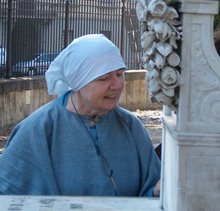
We are gathered here today at an English Tea to celebrate a neglected Florentine international monument, the Swiss-owned so-called ‘English’ Cemetery. Its land was bought by the Chiesa Evangelica Svizzera, the Swiss Evangelical Church, from the Grand Duke in 1827, the same year that the Grand Duke agreed to fund Jean-François Champollion and Ippolito Rosselini's expedition to Egypt and to Nubia. Visit Florence's Archeological Museum to see what they brought back. In 1877, with the medieval wall and the Porta a’ Pinti torn down by Giuseppe Poggi, the Cemetery itself was re-landscaped into this oval, a gardener installed in this house, itself built in 1860. For a century and a quarter more the small Swiss church in Florence owned and cared for this ‘white elephant’. Five years ago they paid half a million euro towards the repair of the wall built originally by the Comune. Though they were given permission for the burial of ashes, such as Evgeni Polyakov's, the derelict state of the cemetery has not encouraged many such burials. Finally the Swiss committee said ‘enough’. It was recommended it be closed and abandoned.
But we had formed a cultural association, with the aid of Carlo Steinhauslin, first for our library and workshop, the Biblioteca e Bottega Fioretta Mazzei, and then to include the Friends of the Cemetery, now named Aureo Anello Associazione Biblioteca e Bottega Fioretta Mazzei e Amici del Cimitero ‘degli Inglesi’, ‘Aureo Anello’ being taken from the plaque on the Brownings’ home, Casa Guidi, in via Maggio, saying that Elizabeth Barrett Browning made of her poetry a golden ring between Italy and the English-speaking world. When the members of the Aureo Anello heard about the closure of the cemetery and the loss of the library and workshop they immediately responded. In particular, we need to restore this cemetery’s Victorian tombs and to landscape it back to the English garden it once had been. We have photographs of the Cemetery as it was with the medieval wall and gate still beside it, taken by Hiram Powers’ son, Longworth Powers, and recently discovered in the Gabinetto Vieusseux. We have Susan and Joanna Horner’s Walks in Florence telling us it was filled with fragrant flowers. With top soil to replace the present weed-killed earth we can again plant lavender and roses and myrtle and laurel and make pot-pourri to give to you.
For it was high time that we English lived up to our part of the name of this place (I was conceived at the League of Nations, Geneva, Switzerland, and born at Devonshire Place, Marylebone, where Elizabeth Barrett Browning lived) and that we pay our debt of gratitude to this city that has inspired so many writers who are buried here, Elizabeth Barrett Browning, Walter Savage Landor, Arthur Hugh Clough, Fanny and Theodosia Trollope, Isa Blagden, and two Pre-Raphaelite artists who sculpted tombstones here, Holman Hunt’s for his wife Fanny who died in childbirth, and John Roddam Spencer Stanhope’s for his daughter Mary, both tombs besides Elizabeth Barrett Browning’s. Immediately the Browning Society, the Victoria Society, Andrew Motion, the Poet Laureate, and Timothy Wilson of the Ashmolean Museum lent their support. We seek to become a UNESCO World Heritage Site. Nor should we forget that we have more than eighty Americans buried here, among them fine sculptors, and Consuls, Hiram Powers having been both, and preachers and writers against slavery, and Louisa, sister to Henry Adams. And we have many Russians, princes and serfs together, buried as Pushkin wrote under the sweet myrtle of Italy.
Many scripts and multiple languages are found here. Many children, many women who died in childbirth, and many friends of Florence Nightinagale lie here. Each tomb has a story to tell, which we have placed on the web, thereby gathering more stories from descendants and scholars world wide. We have the fine sculptures of ‘Speranza’ and ‘Fiducia in Dio’. And most poignantly of all, buried under a most beautiful Orthodox cross in Carrara marble with Cyrillic inscriptions on its base is Nadezda, who was brought here at fourteen, in the year of the Champollion, Rossellini Expedition, from Nubia, a black slave, baptised ‘Speranza’. We can again allow this Cemetery to flourish and be a place of freedom and hope and love and beauty - with your help.
We immediately need to replace the red and white plastic tape with wrought iron posts and chains, while regretting the current dangerous state of the Cemetery. Several tomb stones have fallen, one, of a Polish patriot, right by a group of schoolchildren, so we can no longer permit unaccompanied visitors to walk amongst the tombs. We have books, in particular the limited edition hand bound in marbled paper edition of Elizabeth's Sonnets and Ballad, CDs of Florence in Sepia and other items for sale to benefit the Cemetery, including Linda White Terzani’s Soul Traveller which she can autograph for you. Amalia Ciardi Dupré has re-created Harriet Hosmer’s famous ‘Clasped Hands’ of Elizabeth Barrett and Robert Browning and we can take orders for these. Those of you representing countries of those buried here, Switzerland, America, Russia, Poland, Hungary, Greece, Denmark, Holland, Australia, could tell us which Foundations to approach for the restoration of their tombs. However, we cannot begin to collect funds for this historic landmark until the Chiesa Evangelica Riformata Svizzera in Florence agree not to close and abandon it.




